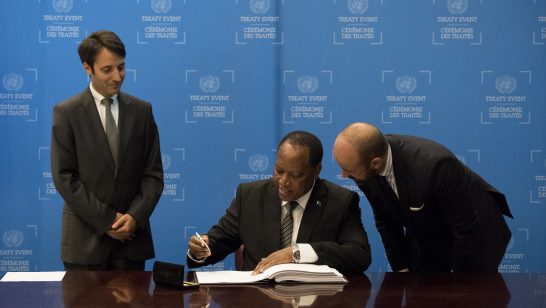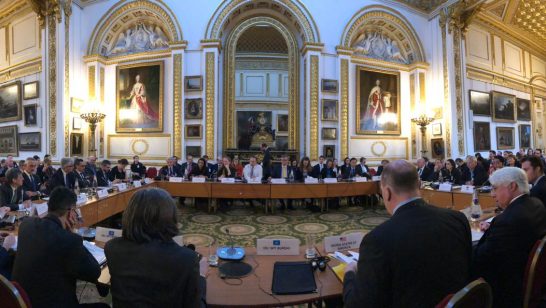
The First Meeting of the States Parties was a new kind of United Nations meeting on non-proliferation. Never have so many young Spanish-speaking women made their case for a nuclear weapon-free world at a UN meeting. Women of the Central American states praised the fact that all states in their region had signed the prohibition treaty. The Latin Americans, in general, were very active in this arena. The region has a long history as a nuclear weapon-free zone. The Treaty of Tlatelolco (the Treaty for the Prohibition of Nuclear Weapons in Latin America and the Caribbean) was approved in 1967, a year before the Non-Proliferation Treaty (NPT), which is often seen as the cornerstone of the nuclear order.
New voices came also from the islands of the Pacific Ocean. The treaty includes an unusual promise of victim assistance and environmental remediation. At the humanitarian conferences that preceded the treaty negotiations (in 2013-14 in Norway, Mexico and Austria), the victims of testing and use of nuclear weapons already had a prominent role. Having been ignored and invisible for years, there was now a UN treaty acknowledging their suffering and promising not only medical but also social and environmental rehabilitation.
Another new aspect was the political will for nuclear disarmament, the commitment to get rid of nuclear weapons, and the will to create mechanisms for this. At the side lines of the meeting, this was belittled by observers who referred to the fact that none of the nuclear weapon states were present and that those states that were present were already in agreement, those opposed had not signed the treaty. While this is true, a parallel with the feminist movement indicates that in the first phases of radical change, it is important for the like-minded to meet first among themselves. This was the first time when states willing to prohibit nuclear weapons were gathered at the same table.
The resulting Vienna Action Plan summarises the core issues with universalisation of the treaty on the top of the list. The ambitious goal is to get all states to sign and ratify the treaty, in effect “universalization should serve as a strategy to maximize the authority of the Treaty´s core norms and principles in international politics”. Through increased awareness of the prohibition norm and through national contact points for promotion, more and more states should choose to join, including the nuclear weapon states. The latter are allowed to join even before they abolish their weapons and a time limit for this was agreed. States with nuclear weapons would have 10 years to become non-nuclear and states without nuclear weapons, but protected by nuclear weapons of others, would have 90 days to exit their “nuclear umbrella” status.
As indicated above, victim assistance is a further priority. States affected should develop plans for assistance and national focal points for information exchange and reporting. The Action Plan further proposes an international fund as a possible financing mechanism. Closely attached to this is the need for scientific understanding, necessary not only for victim assistance but also in order to define what a nuclear weapon is and how its destruction could be verified. The Action Plan includes the creation of a Scientific Advisory Group to help promote the treaty´s implementation and envisages the establishment of an international authority (or authorities) for negotiations and verification (the debate on this was postponed to the intersessional period).
Seen from the outside, and particularly from the states that were present as observers to the meeting (four NATO states, as well as Sweden, Finland and Australia) the most critical question at the meeting was the relationship of the TPNW to the nuclear non-proliferation regime as a whole and to the NPT-Treaty in particular. This question is also answered in the Vienna Action Plan. The TPNW is seen as complementary to the Nuclear Non-Proliferation Treaty (NPT) and in particular to its article VI on negotiations to abolish nuclear weapons. Both deal with disarmament, although the fact that a new treaty had to be approved shows the failure of its implementation within the NPT.
However, on other dimensions there are clear conflicts. The NPT approves that five states, the permanent Security Council members – the P5 – may have nuclear weapons while the TPNW deems this illegal according to international law. Furthermore, the NPT accepts deterrence whereas the TPNW Action Plan talks about “the fallacy of nuclear deterrence doctrines, which are based and rely on the threat of actual use of nuclear weapons and hence, the risks of the destruction of countless lives, of societies, of nations, and of inflicting global catastrophic consequences.”
The only complementarity to Article VI is underlined in this first phase. The strategy seems to be to strengthen the prohibition norm particularly among the non-nuclear states and the umbrella states (states without nuclear weapons but whose security is guaranteed by the nuclear weapons of others, for example all non-nuclear NATO-states) and that increased awareness will gradually lead to the universalisation of the TPNW. This understanding will, no doubt, be challenged at the NPT review conference in August.
Given the current global security environment it was astonishing that so few state representatives referred to the war in Ukraine and the Russian nuclear threats. Although a few representatives did refer to the war, it was in no way a prominent point in the individual statements. This could have been used as a strong argument for prohibition as the Vienna declaration condemns all nuclear threats as illegal, both direct and indirect.
The importance of the TPNW, and the fact that the states are now organised, is built into its prohibition norm. This is stronger than the NPT´s article VI on disarmament, which only reflects a general intention. Nuclear weapons are now prohibited according to international law. Prohibition also challenges deterrence as a dimension of the NPT. The strategy of universalisation and the mechanisms used in its implementation are a welcome specification of how to reach the common goal: a world without nuclear weapons. Furthermore, there is a new balance between the nuclear and non-nuclear states. While the voices of the nuclear weapon states have dominated the implementation of the NPT, new emerging non-nuclear voices are heard on the arena of the TPNW.
The opinions articulated above represent the views of the author(s) and do not necessarily reflect the position of the European Leadership Network or any of its members. The ELN’s aim is to encourage debates that will help develop Europe’s capacity to address the pressing foreign, defence, and security policy challenges of our time.
Image: Flickr, International Campaign to Abolish Nuclear Weapons



